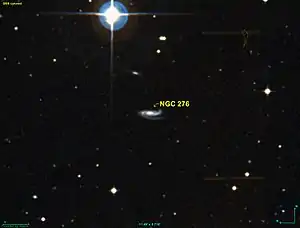NGC 276
NGC 276 is a barred spiral galaxy located approximately 626 million light-years from the Solar System[2] in the constellation Cetus. It was discovered in 1886 by Frank Muller and was later also observed by DeLisle Stewart.[4]
| NGC 276 | |
|---|---|
 NGC 276 as seen on DSS | |
| Observation data (J2000 epoch) | |
| Constellation | Cetus |
| Right ascension | 00h 52m 06.6s[1] |
| Declination | −22° 40′ 49″[1] |
| Redshift | 0.046826[1] |
| Helio radial velocity | 14,038 km/s[1] |
| Distance | 626 Mly[2] |
| Apparent magnitude (V) | 15.68[1] |
| Characteristics | |
| Type | SB[3] |
| Apparent size (V) | 1.0' × 0.4'[1] |
| Other designations | |
| ESO 474- G 034, IC 1591, MCG -04-03-021, 2MASX J00520656-2240486, IRAS 00496-2257, ESO-LV 4740340, 6dF J0052065-224049, PGC 3054.[1] | |
John Dreyer, creator of the New General Catalogue describes the object as "extremely faint, pretty small, extended 265°, 11 magnitude star 3 arcmin to north". The galaxy's right ascension was later corrected in the Index Catalogue using the observation data by Stewart.[4]
References
- "NASA/IPAC Extragalactic Database". Results for NGC 0276. Retrieved September 2, 2016.
- An object's distance from Earth can be determined using Hubble's law: v=Ho is Hubble's constant (70±5 (km/s)/Mpc). The relative uncertainty Δd/d divided by the distance is equal to the sum of the relative uncertainties of the velocity and v=Ho
- "NGC 276". SIMBAD. Centre de données astronomiques de Strasbourg.
- "New General Catalog Objects: NGC 250 - 299". Cseligman. Retrieved October 15, 2016.
External links
- NGC 276 on WikiSky: DSS2, SDSS, GALEX, IRAS, Hydrogen α, X-Ray, Astrophoto, Sky Map, Articles and images
- SEDS
This article is issued from Wikipedia. The text is licensed under Creative Commons - Attribution - Sharealike. Additional terms may apply for the media files.